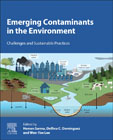
Emerging Contaminants in the Environment: Challenges and Sustainable Practices
Sarma, Hemen
Dominguez, Delfina C.
Lee, Wen-Yee
Emerging Contaminants in the Environment: Challenges and Sustainable Practices covers all aspects of emerging contaminants in the environment, from basic understanding to different types of emerging contaminants and how these threaten organisms, their environmental fate studies, detection methods, and sustainable practices of dealing with contaminants. Emerging contaminant remediation is a pressing need due to the ever-increasing pollution in the environment, and it has gained a lot of scientific and public attention due to its high effectiveness and sustainability. The discussions in the book on the bioremediation of these contaminants are covered from the perspective of proven technologies and practices through case studies and real-world data. One of the main benefits of this book is that it summarizes future challenges and sustainable solutions. It can, therefore, become an effective guide to the elimination (through sustainable practices) of emerging contaminants. At the back of these explorations on sustainable bioremediation of emerging contaminants lies the set of 17 goals articulated by the United Nations in its 2030 Agenda for Sustainable Development, adopted by all its member states. This book provides academics, researchers, students, and practitioners interested in the detection and elimination of emerging contaminants from the environment, with the latest advances by leading experts in emerging contaminants the field of environmental sciences. Covers most aspects of the most predominant emerging contaminants in the environment, including in soil, air, and water Describes the occurrence of these contaminants, the problems they cause, and the sustainable practices to deal with the contaminants Includes data from case studies to provide real-world examples of sustainable practices and emerging contaminant remediation INDICE: 1. Understanding emerging contaminants in soil and water:current perspectives on integrated remediation approaches 2. Emerging environmental contaminants-current status,challenges, and technological solutions 3. Anticancer drugs in the environment: environmental levels and technological challenges 4. Exposure to 1,4-dioxane and disinfection by-products due to the reuse of wastewater 5. Transport, fate, and bioavailability of emerging pollutants in soil, sediment, and wastewater treatment plants: potential environmental impacts 6. Pharmaceutical and personal care products in the environment: occurrence and impact on the functioning of the ecosystem 7. Excessive pharmaceutical and personal care products in the environment cause life-threatening diseases 8. A broad perspective on antimicrobial resistance in coastal waters 9. Environmental fate and transportation of perfluorinated compounds 10. Engineered nanomaterials: threats, releases, and concentrations in the environment 11. Plastic pollution in marine and freshwater environments: abundance, sources, and mitigation 12. Electronic waste: an emerging contaminant in the geo- environment 13. Effects of pesticides on human physiology, genetics,and evolution 14. Integrative behavioral and ecotoxicological effects of nanoparticles 15. Determination of multiclass emerging contaminants using QuEChERS method 16. Removal of quinolone antibiotics from wastewaters and sewage sludge 17. Chemosensing technology for rapid detection of emerging contaminants 18. Methods of bisphenol A detection by gas chromatography and mass spectrometry (GC-Ms) in human breast milk and foodstuff 19. Microalgae as whole-cell biosensors in the prospective assessment of toxic effects of emerging contaminants 20. The mixture of agricultural pesticides and their impact on populations: bioremediation strategies 21. Assisted and amended technology for the sustainableremediation of emerging contaminants 22. Bioremediation of cytostatic pharmaceutical and personal care products and emerging technologies 23. Removal of antimicrobial resistance determinants from wastewater: a risk perspective on conventional and emerging technologies 24. Novel nanomaterials for nanobioremediation of polyaromatic hydrocarbons
- ISBN: 978-0-323-85160-2
- Editorial: Elsevier
- Encuadernacion: Rústica
- Páginas: 712
- Fecha Publicación: 24/01/2022
- Nº Volúmenes: 1
- Idioma: Inglés
